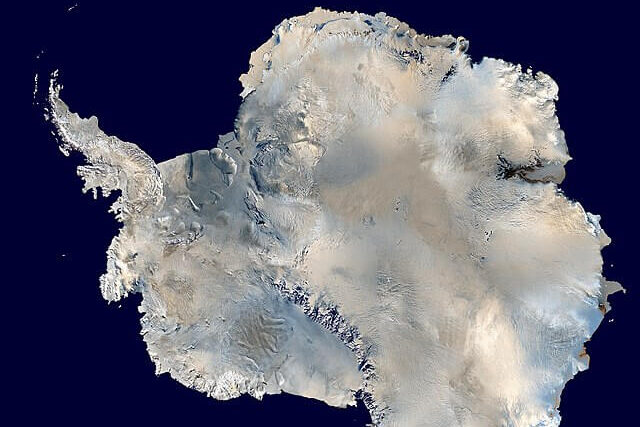
New research suggests that the melting ice sheet in Antarctica could retreat at a much faster rate than previously anticipated. The evidence comes from markings on the seafloor off the coast of Norway, which record the withdrawal of a melting European ice sheet thousands of years ago. The retreat of the fastest withdrawing glaciers in Antarctica today is already reaching speeds of up to 30 meters per day. However, if these glaciers accelerate further, the additional meltwater could have significant implications for global sea-level rise.
The loss of ice from Antarctica due to climate change has already contributed to a nearly 1cm increase in the surface of the world’s oceans since the 1990s. The researchers discovered that the maximum retreat recorded from the Norwegian ice sheet was more than 600 meters per day. Dr. Christine Batchelor from Newcastle University in the UK explains that such a scenario could occur if the upper estimates for temperature rise are realized. Alarmingly, their calculations indicated that even under the current basal melt rates, similar episodes of rapid retreat could occur in Antarctica.
Dr. Batchelor and her colleagues published their findings in the journal Nature. The team examined a large expanse of seafloor off the central coast of Norway. This area witnessed the withdrawal and breakup of a massive Northern European ice sheet around 20,000 years ago. The ice sheet’s presence is reflected in over 7,600 parallel ridges on the seafloor, spaced between approximately 25 and 300 meters apart. These ridges, which are less than 2.5 meters high, are believed to be formed at the ice grounding zone.
The ice grounding zone is where glacier ice flowing from land into the ocean becomes buoyant and begins to float. The ridges are created as the ice repeatedly interacts with the muddy sediments on the seafloor during the daily tidal cycles. The preservation of these features indicates that the ice was in retreat, as advancing ice would destroy the ridges. By examining the tidal “clock” imprinted on the seafloor, the scientists were able to determine the rate of this reversal.
The team’s results indicate that the former European ice sheet experienced periods of rapid retreat at speeds ranging from 55 to 610 meters per day. Significantly, the fastest rates of retreat were observed in areas where the seafloor was relatively flat. These locations have a more uniform ice thickness, requiring less melting for the ice to become buoyant and facilitate its retreat.
While similar ridges have been found on the seafloor around Antarctica, their extent is limited compared to the vast study area off the coast of Norway. Therefore, the Norwegian study provides a clearer understanding of how quickly ice can retreat in a warming climate.
Currently, scientists use satellite observations to monitor the grounding zones of Antarctica’s glaciers that terminate in the ocean. These spacecraft can track the vertical movement of the ice in response to tidal fluctuations. The fastest retreat observed thus far occurred at Pope Glacier in western Antarctica, with an average rate of 33 meters per day over a 3.5-month period in 2017. However, researchers are particularly concerned about massive glaciers like Thwaites, which is roughly the size of Britain and has the potential to raise global sea levels by half a meter if it were to completely melt.
“Four kilometres inland of the current grounding line at Thwaites, there is a conduit-like channel where the seabed is flat. It is the perfect setting for this process of buoyancy-driven retreat,” said co-author Dr Frazer Christie of the Scott Polar Research Institute (SPRI), Cambridge University, UK.
“We’re talking about a small area compared with Thwaites’ entire drainage basin, but even a short-lived, very rapid retreat will have implications for the future dynamics of the glacier.”
Drs Batchelor and Christie say their team’s observations will fine-tune the computer models that try to forecast Antarctica’s destiny in an ever-warming world. At the moment, these models are missing important details of ice behaviour.
“But this is why we look into the geological past to tell us what’s possible. Yes, we have satellites, but their records are very short – only 40 years or so,” commented co-author Prof Julian Dowdeswell, also from SPRI.
“Importantly, the geological record is something that has actually happened. It’s an ‘observation’ in the real world, not just in the computer model world,” he told BBC News.
——————————————————————————
At Natural World Fund, we are passionate about stopping the decline in our wildlife.
The declines in our wildlife is shocking and frightening. Without much more support, many of the animals we know and love will continue in their declines towards extinction.
When you help to restore a patch of degraded land through rewilding to forests, meadows, or wetlands, you have a massive impact on the biodiversity at a local level. You give animals a home and food that they otherwise would not have had, and it has a positive snowball effect for the food chain.
We are convinced that this is much better for the UK than growing lots of fast-growing coniferous trees, solely to remove carbon, that don’t actually help our animals to thrive.
This is why we stand for restoring nature in the UK through responsible rewilding. For us, it is the right thing to do. Let’s do what’s right for nature!
Support our work today at https://naturalworldfund.com/ and join in the solution!

